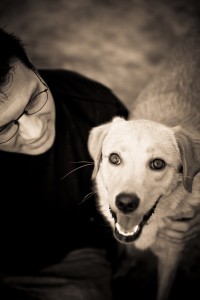This occurred to me while I was sitting at a table with some amazing men and women. I love modern reward-based dog trainers. Of course, the people at the table were themselves trainers. That’s what got me thinking about this. We were chatting and agreeing and disagreeing. The energy in the room made it feel like I was among good friends or family, even though some of us had just met. Maybe I would have felt differently in a room of different trainers. Perhaps, I just got lucky with this group. Perhaps not.
The truth is I’ve met a lot of modern reward-based trainers who just “get it.” For starters, they know what I mean by modern. We don’t just fill a stagnant position in the history of dogdome. We are fluid, developing, writing history as it comes to pass. We grow; we learn and teach and learn some more. We challenge our knowledge-base, support the things we know as true, cast aside the gimmicks and mythology. We test the fundamentals of the past. All the while we build the future.
That’s another thing I love. Reward-based trainers are by definition builders. We build behavior, of course. Behavior reinforced becomes stronger and more frequent. We are the craftspeople who imagine what can be and then build it in the lives of others. We are coaches and cheerleaders, teachers who draw the best from dogs and their people. We break nothing, including bad habits. We build good habits; we build good relationship; we build hope.
Hope. That’s what I was thinking about when I sat down with these good men and women. These folks, these modern trainers, these people with me now are a hopeful bunch. On their worst days they can still look at a dog and find some goodness. It’s the foundation on which they build. Knowledge and experience fuel the work. Hope fuels the trainer. It got them here; it keeps them going. Hope is the stuff of smiles and wags, clicks and treats, tough cases in the win column. Hope finds the goodness in even the most troublesome dog, and the most difficult people.
There, of course, is the rub. These men and women of goodness are multi-species practitioners. It is our own kind who tests our metal the most. Train my dog. You’re his last hope. He’s been this way for years but we need to fix this now. Can’t you see me sooner? Do you offer a discount? How long will this take? I don’t really believe in using treats. They keep us up at night, the dogs who love to learn, the people who don’t. Sometimes they become the cases lost, the dogs surrendered or dead, the people we never hear from again. We become hard-faced, angry. So often, we cry. Here I sit with men and woman who know but rarely speak the pain and frustration. Hope. They draw from a deep well, every one of them. I know.
I’m humbled. I look around the room and wonder do they believe in me as I believe in them? They are brilliant students and teachers, growing and changing. Even now they are writing history, testing the past and building the future. My mind wanders to our unusual life’s work: dogs and people. Here I sit with such noble advocates for the former and amazing examples of the latter. Then I smile.
How could I not love them?
This occurred to me while I was sitting at a table with some amazing men and women. I love modern reward-based dog trainers. Of course, the people at the table were themselves trainers. That’s what got me thinking about this. We were chatting and agreeing and disagreeing. The energy in the room made it feel like I was among good friends or family, even though some of us had just met. Maybe I would have felt differently in a room of different trainers. Perhaps, I just got lucky with this group. Perhaps not.
The truth is I’ve met a lot of modern reward-based trainers who just “get it.” For starters, they know what I mean by modern. We don’t just fill a stagnant position in the history of dogdome. We are fluid, developing, writing history as it comes to pass. We grow; we learn and teach and learn some more. We challenge our knowledge-base, support the things we know as true, cast aside the gimmicks and mythology. We test the fundamentals of the past. All the while we build the future.
That’s another thing I love. Reward-based trainers are by definition builders. We build behavior, of course. Behavior reinforced becomes stronger and more frequent. We are the craftspeople who imagine what can be and then build it in the lives of others. We are coaches and cheerleaders, teachers who draw the best from dogs and their people. We break nothing, including bad habits. We build good habits; we build good relationship; we build hope.
Hope. That’s what I was thinking about when I sat down with these good men and women. These folks, these modern trainers, these people with me now are a hopeful bunch. On their worst days they can still look at a dog and find some goodness. It’s the foundation on which they build. Knowledge and experience fuel the work. Hope fuels the trainer. It got them here; it keeps them going. Hope is the stuff of smiles and wags, clicks and treats, tough cases in the win column. Hope finds the goodness in even the most troublesome dog, and the most difficult people.
There, of course, is the rub. These men and women of goodness are multi-species practitioners. It is our own kind who tests our metal the most. Train my dog. You’re his last hope. He’s been this way for years but we need to fix this now. Can’t you see me sooner? Do you offer a discount? How long will this take? I don’t really believe in using treats. They keep us up at night, the dogs who love to learn, the people who don’t. Sometimes they become the cases lost, the dogs surrendered or dead, the people we never hear from again. We become hard-faced, angry. So often, we cry. Here I sit with men and woman who know but rarely speak the pain and frustration. Hope. They draw from a deep well, every one of them. I know.
I’m humbled. I look around the room and wonder do they believe in me as I believe in them? They are brilliant students and teachers, growing and changing. Even now they are writing history, testing the past and building the future. My mind wanders to our unusual life’s work: dogs and people. Here I sit with such noble advocates for the former and amazing examples of the latter. Then I smile.
How could I not love them?

